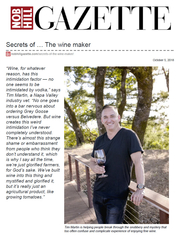Secrets of … The wine maker
By Michelle Konstantinovksy
“Wine, for whatever reason, has this intimidation factor — no one seems to be intimidated by vodka,” says Tim Martin, a Napa Valley industry vet. “No one goes into a bar nervous about ordering Grey Goose versus Belvedere. But wine creates this weird intimidation I’ve never completely understood. There’s almost this strange shame or embarrassment from people who think they don’t understand it, which is why I say all the time, we’re just glorified farmers, for God’s sake. We’ve built wine into this thing and mystified and glorified it, but it’s really just an agricultural product, like growing tomatoes.”
Martin believes the unnecessarily snooty attitude that prevails in viticulture only prevents would-be wine connoisseurs from learning the ropes. As co-founder and partner at Tusk and Immortal Estates, respectively, Martin makes it his business to make wine accessible, interesting, and just plain fun. “The truth is, your palate is smarter than you are and smarter than anything you’re going to read,” Martin says. “A lot of books will give the basics, but I believe the best way to start learning is to start drinking. As with any food product in the world, your palate becomes educated via taste, and as you start trying more, the more questions will come up, and the more you’ll want to learn. Start by drinking, and let that lead to exploration into whatever you like.”
Learning curve.
You don’t need to study up, but if you’re totally new to whites, reds and everything in between, Martin says getting to know a few facts can set you up for success. “The first thing you want to learn about is that there are many varietals — chardonnay, cabernet, pinot, etc.,” he says. “You learn about those and then you learn that varietals in Napa are a little different than those in Sonoma, which are a little different than those from Mendocino, and you start to ask why. Then you learn there are different terroirs — a French word for everything that happens in a regional environment, like the soil type.”
The rules are: There are no rules.
“Diversify and don’t be intimidated by rules,” Martin says. “I’ve heard all these things like, ‘Oh, I can’t have white wine with red meat’ — why can’t you? Some-one made up these arbitrary rules. Some are based in ideas like a powerful cab may overpower halibut, which may be true, but if that’s what you like, and you like that contrast, no one has factored that in. I’ve found so many interesting pairings that go against the rules. Your palate learns when you test it and push it, so my rules are to explore and diversify and not get caught up in very structured rules. Exploration brings creativity, and that’s borne out of someone taking a risk.”
Fine dining.
When it comes to taking his palate out on the town, Martin has a few go-to spots throughout the Bay. “I have two favorite restaurants in the city,” he says. “One is Quince, which is obviously amazing and such a fantastic restaurant in terms of having really high-end food and wine. I love Coqueta on the waterfront. In Napa Valley, one of my favorites is Bouchon — the meals are always spot-on, and it’s delicious French cuisine done right. Don Giovanni is an- other one that’s been doing this for 20-something odd years, where I always have a good experience.
Raise a toast.
As a founder of Tusk Estates and a partner in Immortal Estates, Martin clearly has a stake in the wine game. But that doesn’t mean he’s not a fan of other makers. “Obviously, I’m biased,” he says. “Immortal is my brand, and Tusk is my brand, but Scarecrow is another incredible brand, there’s another winery here called Brand that’s really delicious, and a company called Melka that makes quite a few different, beautiful, well-made wines.”
Cougar juice conundrum.
It’s safe to say that one varietal in particular has gotten a pretty bad rap among winos: Chardonnay. “In the U.S., we’ve placed tiers on wines, like cabs are the best, and that’s how we price them, and that’s how people view them, which is part of that snobbery,” Martin says. “‘Oh, you only drink chardonnay, or you only drink Riesling … eventually you’ll grow into your palate.’ That’s like saying, ‘Oh, you only like regular oranges, but everyone loves blood oranges — you’re just not quite ready for those.’”
A perfect pick.
With so many factors — origin, year, flavor profile, etc. — choosing a wine can be a bit overwhelming. But Martin says trusting your gut and adding in a little bit of knowledge can go a long way. “You want to look for estate fruit from an actual vineyard source,” he says. “When you get into wine, you can start to know, ‘Oh, that’s an Oakville Cab. That’s a really good area that produces high-end Cabs, so even if I’ve never tried it, I have a better shot with it than say a Mendocino cab, since that area isn’t known for Cabs.’ That’s not to say it couldn’t be made there, but it’s a little bit more of a crap shoot. Knowing the region and varietals that are best in that region plays a huge role for me when I’m in a restaurant guessing and exploring and trying something new.”
A break from the norm.
Everyone needs a breather now and then. So what does a wine expert drink when vino isn’t on the menu? “I love tequila and mezcal,” Martin says.

